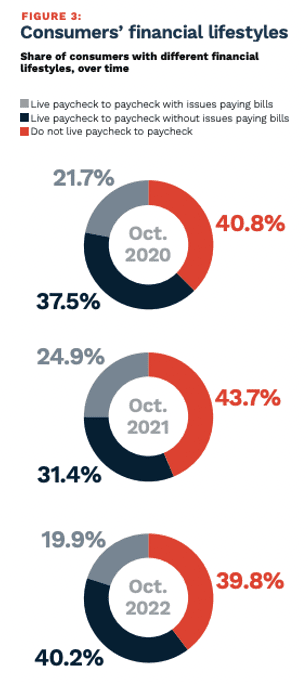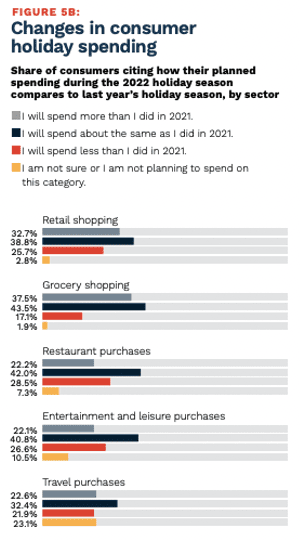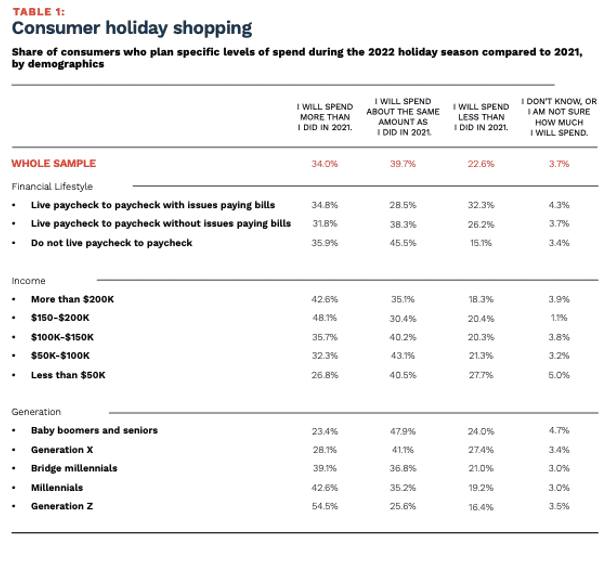Holiday Spending out of Reach for Millions of Households This Year
Visions of sugarplums could be the only thing millions of Americans can count on getting during the 2022 holidays, as new PYMNTS data has uncovered a painful insight into how inflation is eroding personal buying power.

This, as the latest New Reality Check: The Paycheck-To-Paycheck Report: The Holiday Shopping Edition, a PYMNTS and LendingClub collaboration, discovered that 15 million consumers who shopped for gifts in 2021 wouldn’t be doing so this year.
In all, 79% of respondents said they would shop for the 2022 holiday season, marking a nearly nine percentage point drop from the 88% who shopped last year.
“It’s such a sad statistic that came out of this report,” Anuj Nayar, financial health officer at LendingClub, told PYMNTS. “That means people are not buying gifts, many for the first time.”
With the ranks of paycheck-to-paycheck households rising four percentage points to 60% since October 2021, the new study finds that malaise is spreading to middle-income and high-income earners, with 65% of those earning $50,000 and $100,000 and 43% of those earning over $100,000 now living paycheck to paycheck, a rise of 58% and 38%, respectively.
Nayar found it particularly concerning that more Americans plan to make holiday purchases with credit cards and alternatives like buy now pay later (BNPL) when the open-to-buy on the average credit card is nearly exhausted, and POS credit carries issues of its own.
Remarking on report findings that 40% of Americans plan to use some form of financing to manage their holiday spending, Nayar said: “If you’re using credit cards for convenience, knock yourself out. But most people are not.”
“Credit card debt is at an all-time high. Credit card rates are reaching all-time highs,” he added. “What the report showed was that, specifically for those who are struggling to pay their bills, they are almost saturating their credit card balances. They have on average, I think, a $4,500 balance, and they are at 97% of that.”

Specifically, the latest data shows that bridge millennials, millennials and Gen Z cohorts “plan to finance an average of 42% of their purchases, while baby boomers and seniors plan to finance an average of 37% of their holiday purchases. The older generations mainly use their credit cards and pay them off over time, while younger generations are more likely to use alternative forms of financing, such as BNPL and personal loans.”
2022 Holidays Stress Meals Over Deals
Finding bright spots in the Holiday Shopping Edition requires a microscope. The only real uplifting statistic is that paycheck-to-paycheck households prioritize family meals over gifting, even though food inflation remains at troubling highs, as they have all year.
“Walmart recently had their earnings call, and they were talking about how their same-store sales are up 8%, but it’s not consumer discretionary, it’s not big-ticket items, it’s food,” he said.
Per the study, “Just 17% of grocery shoppers expect to spend less on grocery purchases than in 2021, though 26% of retail shoppers plan to spend less on retail purchases in 2022.”
While new data shows that restaurant spending will be down, Nayar noted that the cost of Thanksgiving meal staples is so high that a better deal may be found at a quick service chain.
“You can go to Boston Market and get a Thanksgiving meal for 12 people for $160,” he said. “That’s a turkey, three different sides, two different pies plus an appetizer, and everything for $160. I did the math” and doubted a shopper could get the basic ingredients for that sum.
See also: Addressing America’s Financial Health Crisis

The New Way of Life
The fact that the number of households living paycheck-to-paycheck without trouble paying bills now equals the share of consumers not living paycheck-to-paycheck at all is indicative of the cost-of-living creep that shows no sign of letting up in 2023, with a recession looming.
“That’s a turning point. That’s a big pivot,” Nayar said. “That’s a sign that this has become a normal way of living. This is not so much the temporary ‘let me get through this for the holidays and then in January have a reset.’ People are starting to live this way for months and unfortunately years on end without being able to put [money] aside” for retirement and more.
It’s putting more of a bite on consumers, even in the highest income brackets. The report states that “23% of all consumers who plan to make purchases during the 2022 holiday season expect to spend less than they did in 2021. Paycheck-to-paycheck consumers with issues paying bills are the most likely to cut back: 32% of these consumers plan to reduce their spending, compared to 26% of paycheck-to-paycheck consumers living without issues paying bills and just 15% of those not living paycheck to paycheck.”
